Antonov An-26
The Antonov An-26 (NATO reporting name: Curl) is a twin-engined turboprop civilian and military transport aircraft, designed and produced in the Soviet Union from 1969 to 1986.[1]
| An-26 | |
|---|---|
 | |
| An-26 of the Serbian Air Force | |
| Role | Transport aircraft |
| National origin | Soviet Union |
| Design group | Antonov |
| First flight | 21 May 1969[1] |
| Introduction | 1970 |
| Status | Operational |
| Primary users | Soviet Air Force Pakistan Air Force Vietnamese Air Force |
| Produced | 1969–1986 |
| Number built | 1,403 |
| Developed from | Antonov An-24 |
| Variants | Antonov An-32 |
Development
After successful operations of the An-24T tactical transport in austere locations, interest in a version with a retractable cargo ramp increased. Initial studies for the retractable ramp were carried out as part of the projected An-40 medium transport. When given the go-ahead for the An-26 in March 1968, the Antonov OKB adapted the ramp design of the An-40 to the An-24 fuselage, resulting in the An-26. Particular attention was given to the military mission, and the majority of early An-26 production was delivered to the VTA (voyenno-transportnaya aviatsiya).[1]
Using the majority of the An-24 airframe, with its high-set cantilevered wings, twin turboprops and stalky main undercarriage, the An-26 included military equipment, such as tip-up paratroop canvas seats, an overhead traveling hoist, bulged observation windows and parachute static line attachment cables. The An-26 made its public debut at the 27th Paris Air Show at Le Bourget where the second prototype, CCCP-26184 (c/n00202), was shown in the static aircraft park.
The An-26 is also manufactured without a license agreement[1] in China by the Xian Aircraft factory as the Y-14, later changed to be included in the Xian Y7 series.[1]
Total production
| Total Production[2] | 1986 | 1985 | 1984 | 1983 | 1982 | 1981 | 1980 | 1979 | 1978 | 1977 | 1976 | 1975 | 1974 | 1973 | 1972 | 1971 | 1970 | 1969 |
|---|---|---|---|---|---|---|---|---|---|---|---|---|---|---|---|---|---|---|
| 1159 | 1 | 53 | 33 | 54 | 77 | 86 | 125 | 149 | 130 | 103 | 99 | 77 | 62 | 35 | 36 | 21 | 14 | 4 |
Operational history
The An-26 has a secondary bomber role with underwing bomb racks. The racks are attached to the fuselage in front of and behind the rear landing gear. In the bombing role it was extensively used by the Vietnam People's Air Force during the Cambodian–Vietnamese War and Sudanese Air Force during the Second Sudanese Civil War and the War in Darfur.[3] Also Russian Forces train with the An-26 as a bomber.[4]
Variants
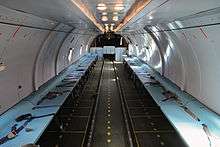
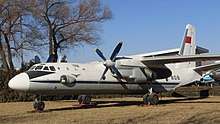
- An-26
- "Curl-A" : Twin-engine tactical transport aircraft.[1]
- An-26-100
- Convertible passenger/cargo aircraft modified from 'An-26' aircraft at the Kiev plant from 1999.[1]
- An-26 Nel'mo
- An arctic surveillance and reconnaissance aircraft retrofitted with Nel'mo equipment.[1]
- An-26 Pogoda
- (Weather) Another aircraft for weather control duties, similar to the 'An-26 Tsiklon ', with a simplified equipment test lab.[1]
- An-26 Polyot
- (Flight) A single aircraft retrofitted for the purpose of research of unified air traffic control and monitoring system throughout the USSR, with a comprehensive navigation test lab including precision compasses and Doppler speed/shift sensors.[1]
- An-26 Sfera
- (Sphere) A single production aircraft built as a laboratory for atmospheric research.[1]
- An-26 Shtabnoy
- (Shtab: or Headquarters) some 'An-26's delivered to the Soviet and DDR air forces for use as staff transports/mobile command posts.[1]
.jpg)
- An-26 Vitauk
- (Life) A single mobile operating room, surgery and intensive care unit ('25 Blue', c/n5406), for the Ukrainian Air Force.[1]
- An-26A
- A one-off assault transport prototype with higher performance due to removal of some military equipment.[1]
- An-26ASLK
- (Avtomatizirovannaya sistema lyotnogo kontrolya – automated flight control and monitoring system) : A modern flight control and monitoring system equipped with automatic calibration and navigation systems. Recognizable by the distinctive pod low on the forward fuselage side.[1]
- An-26B
- A civil cargo version equipped with roller gangsways which can be swung up against the cabin walls when not in use. It was also equipped with two ZMDB Progress (Ivchyenko) Al-24VT turboprop powerplants to deliver higher thrust.[1]
- An-26B
- 'Mobile Hospital' : The prototype 'An-26B' retrofitted as a mobile civilian emergency hospital.[1]
- An-26B Tsiklon
- (Cyclone) A weather research/control and cloud-seeding aircraft for the Central Aerologic Laboratory. This aircraft was used for rain induction and protection using cloud-seeding chemicals dropped from slab-sided pods hung from pylons.[1]
- An-26B-100
- Convertible passenger/cargo aircraft modified from 'An-26B' aircraft at the Kiev plant from 1999.[1]
- An-26BL
- Alternative designation for the 'An-26L'.[1]
- An-26BRL
- Alternative designation of the 'An-26RL' Arctic surveillance and reconnaissance aircraft.[1]
- An-26D
- (Dal'niy – long-range) An extended range version with extra fuel in wing tanks and additional external tanks attached to the airframe of the fuselage. One aircraft ('21 Yellow', c/n 13806) was retrofitted and delivered, but no further orders were forthcoming.[1]
- An-26K Kaira
- (Great Auk) A single An-26 aircraft converted to a Kaira test airframe for the development of airborne LASER guided systems.[1]
- An-26K Kaplya
- (Drop [of liquid]) After completion of the LASER designator trials the 'An-26K Kaira' was retrofitted to search or optically guided weapons as the navigation systems. During a night test flight at low level, in March 1989, the An-26K Kaplya suffered a massive bird strike, which consequently destroyed the windshield and injured the pilot, who involuntarily downed the aircraft into the Azov Sea.[1]
- An-26KPA
- (Kontrol'no-Poverochnaya Apparatura – Testing and calibration equipment) : A navigation aids inspecting aircraft with comprehensive navigation equipment and calibration equipment.[1]
- An-26L
- A single 'An-26', (14 Orange, c/n 00607), used at Sperenberg Airfield near Berlin, for airfield and NAVAID calibration.[1]
- An-26LL-PLO
- (Letayuschaya Laboratoriya – Protivolodochnoy Oborony – ASW (Anti-Submarine Warfare) testbed) : A single 'An-26A' aircraft, (c/n 0901), retrofitted and modified to accommodate range of sophisticated laboratory for surveillance systems, detecting and tracking stealthy nuclear submarines.[1]
- An-26LP
- Firefighting version, for delivery of field equipment and para-dropping firefighters in lieu of water-bombing (any more info?).[1]
- An-26M Spasatel
- (Rescue worker) Flying hospital with an emergency surgery facility and consultation conference room.[1]
- An-26P
- (Protivopozharnyy – firefighting) : Aircraft fire engine fighter, retrofitted with water lifting vessels in pods on either side of the lower fuselage.[1]
- An-26P Prozhektor
- (Projector or Searchlight) A single conversion of an An-26 as a guided missile system airframe.[1]
- An-26REP
- (RadioElektronnoye Protivodeystviye – ECM (Electronic Counter-Measures) [aircraft]) : Electronic countermeasures aircraft fitted with active jammers in cylindrical pods on either side of the lower fuselage sides, as well as chaff and I/R flares for self-defense.[1]
- An-26RL
- (Razvedchik Ledovyy – An arctic surveillance, reconnaissance and monitoring) : An arctic surveillance, reconnaissance and monitoring aircraft used to monitor the icebergs and ice formations at arctic circle fitted with SLAR (Sideways Looking Airborne Radar) in long pods on either side of the lower fuselage, extra fuel in a cargo hold fuel tank, provision for surveyors and radar operators.[1]
- An-26RT
- "Curl-B": (First use of the designation) A basic designation for a series of ELINT aircraft fitted with a wide range of electromagnetic surveillance equipment. At least one aircraft, (tactical code '152'), retrofitted with the Tarahn (Ramming Attack) ELINT suite for use in Afghanistan.[1]
- An-26RT
- (ReTranslyator – Interpreter -Translator): (Substitute of designation) Battlefield communications relay aircraft, fitted with powerful Inzheer (Fig) radio relay system, for connecting forward units to headquarters units.[1]
- An-26RTR
- Alternative unit designation of the 'An-26RT' ELINT aircraft.[1]
- An-26S
- (Salon – [VIP] Lounge) : A new VIP Lounge aircraft for the Ukrainian Ministry of Defense delivered about 1997.[1]
- An-26Sh
- (Shturmanskiy – Navigator) : Navigator trainer for the VVS, 36 built at Kiev.[1]
- An-50
- A proposed jet-powered variant of the An-26.
Non-USSR /-Ukrainian versions
.jpg)
- An-26SM
- One aircraft modified for NAVAID calibration and flight monitoring for the East German Air Force and transferred to the post-unification German Air Force.[1]
- An-26M
- One aircraft modified as an ELINT aircraft for the East German Air Force and transferred to the post-unification German Air Force.[1]
- An-26ST
- East German special duties aircraft.[1]
- An-26T
- Unofficial East German designation for 'An-26's' operated by Transportfliegerstaffel 24 (transport squadron 24).[1]
- An-26Z-1
- Czechoslovakian ELINT conversion of one aircraft for ELINT duties.[1]
- Xian Y-14
- Initial designation of the 'AN-26' copy, later changed to 'Y-7H' (Hao – cargo).[1]
Operators
Military operators
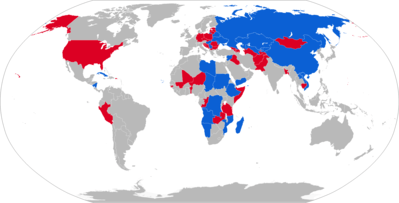
_45158988.jpg)
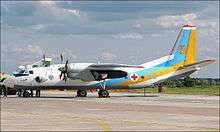
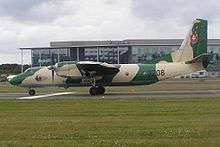

- National Air Force of Angola – one An-24 or An-26 operated December 2015.[5]
- Belarusian Air Force – three operated December 2016.[6]
- Cape Verde Army – 3
- Chad Air Force – three in service December 2016.[7]
- 23 Xian Y-7; 4 Xian Y-7-100; includes all types of Y-7 aircraft
- Democratic Republic of the Congo Air Force – two in service December 2015.[9]
- Ethiopian Air Force – one
- Ivory Coast Air Force – two in service August 2018.[10]
- Kazakh Air Force – five An-24 or An-26 in service December 2015.;[11] Received one refurbished An-26 from Ukraine on 3 November 2017.[12]
- Lao People's Liberation Army Air Force – one in service December 2016.[11]
- Libyan Air Force – two An-24/An-26 as of December 2016.[11]
- Malagasy Air Force – one
- Moldovan Air Force – one as of December 2016.[15]
- Mozambique Air Force – one as of December 2016.[15]
- Namibian Air Force – one as of December 2016.[15]
- Nicaraguan Air Force – four as of February 2018.[16][17]
- Russian Air Force – 104 as of December 2016.[19]
- Russian Naval Aviation[19]
- Border Guard Service of Russia
- Serbian Air Force – two in service, four in reserve as of December 2016.[20]
- Sudanese Air Force – six as of December 2016;[21] at least one used as an improvised bomber
- Syrian Air Force – two as of December 2016;[22] one crashed
- Ukrainian Naval Aviation – two as of December 2016[23]
- Ukrainian Air Force – around 22 as of 2017[24]
- Uzbek Air Force – four as of December 2016[25]
- Vietnamese Air Force – 30 as of December 2016[25]
- Yemen Air Force – six
Former military operators
- Afghan Air Force – All remaining aircraft retired June 2011. One of their An-26 which defected to Pakistan, is preserved at PAF Museum, Karachi
- Benin Air Force – two[26]
- Bulgarian Air Force – five used from 1984 until 2011[24]
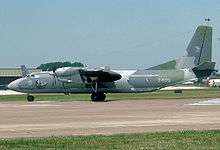
- Congolese Air Force – one
- Czechoslovakian Air Force
- Hungarian Air Force – 11 delivered from 1974, last one retired June 2020.[24][27]
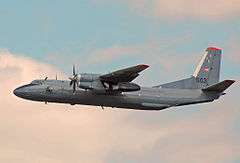
- Mongolian Air Defense Forces Command – four
.jpg)
- Lithuanian Air Force – three operated
- Air Force of Mali
- Niger Air Force – one
- North Yemen Air Force
- Pakistani Air Force
- Peruvian Air Force – 22 operated from 1977 to 1993
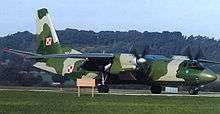
- Polish Air Force – 12 operated from 1972 to January 2009; retired[28]
- Romanian Air Force – Replaced by Alenia C-27J Spartan before 2017[24]
- Slovak Air Force – Two, retired in 2016, to be replaced by Alenia C-27J Spartan aircraft beginning in 2017.[29][30][31]
- Somali Air Corps
- Soviet Air Force – Passed on to successor states in 1991
- Soviet Naval Aviation –
- Tanzanian Air Force – none; retired
- Military of Turkmenistan – ten
- United States Air Force – Operated 2003–2007 by the 6th Special Operations Squadron[32]
- Yugoslav Air Force – 14
Civil operators
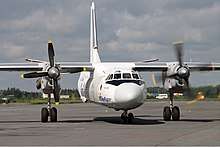
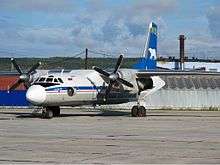
.jpg)
- Genex (two)
- Air Bright (one)
- Sadelca (one)
- Servicio Aéreo del Vaupés SELVA (three)
- Aerogaviota (three)[33]
- SAS Cargo Group (one)
- CityLine Hungary (four)
- RAF-Avia (five)
- Valan International Cargo Charter[34]
- Aero Condor (one)
- Amazon Sky (two)
- ATSA (one)
- Cielos Andinos (two)
- Exin (six)
- Angara Airlines (three)[35]
- Chukotavia (three)[36]
- IrAero (ten)[37]
- Khabarovsk Airlines (three)[38]
- Kostroma Air Enterprise (four)[39]
- KrasAvia (four)[40]
- Polar Airlines (three)[41]
- Tajik Air (one)
- Air Urga (ten)
- Antonov Airlines (one)[42]
- ARP 410 Airlines (five)
- Constanta Airline (four)[43]
- Vulkan Air (three)[44]
- SolarCargo
| UGA – (Upravleniye Grazhdanskoy Aviatsii – Civil Aviation Directorate) | OAO – (Otdel'nyy Aviaotryad – independent flight detachment) | LO – (Lyvotnyy Otryad – flight squad) / Aviaeskadril'ya – squadrons) | Home Base | CIS (Commonwealth of Independent States) Airline) |
|---|---|---|---|---|
| Azerbaijan | Baku | 360th / 1st & 3rd squadrons | Baku-Bina | AZAL (no An-26s) |
| Belarusian | Gomel' | 105th / 2nd squadron | Gomel' | Gomel'avia |
| 1st Minsk | 353rd / 2nd Squadron | Minsk-Loshitsa (Minsk-1) | Belavia;Minsk-Avia | |
| Central Regions | Bykovo | 61st / 4th Squadron | Moscow-Bykovo | Bykovo Avia |
| Kursk | Kursk | Kurskavia | ||
| Tula | 294th | Tula | Tula Air Enterprise | |
| East Siberian | Chita | 136th / 1st Squadron | Chita | Chita Avia |
| Irkutsk | 134th | Irkutsk-1 | Baikal Airlines | |
| Far Eastern | 1st Khabarovsk | 289th | Khabarovsk | Dalavia Far East Airlines Khabarovsk |
| Kamchatka CAPA / Petropavlovsk | Petropavlovsk-Kamchatskiy | Petropavlovsk-Kamchatsky Air Enterprise | ||
| Sakhalin CAPA / Yuzhno-Sakhalinsk UAD | 147th | Yuzhno-Sakhalinsk / Khomutvo | Sakhalinskiye Aviatrassy | |
| Komi | Pechora | Pechora | Komiavia;Komiinteravia | |
| Krasnoyarsk | Igarka | 251st | Igarka | |
| 2nd Krasnoyarsk | 126th | Krasnoyarsk-Severnyy | Kras Air | |
| Khatanga | 221st / 2nd Squadron | Khatanga | ||
| Leningrad | 2nd Leningrad | 70th / 2nd Squadron | Leningrad-Rzhevka | Rzhevka Air Enterprise |
| Pskov | 320th / 2nd Squadron | Pskov | Pskov Avia | |
| Lithuanian | Vilnius | 277th | Vilnius | Lithuanian Airlines |
| Magadan | Anadyr' | 150th / 2nd Squadron | Anadyr'-Ugol'nyy | Chukotavia |
| 1st Magadan | 185th | Magadan-Sokol | Kolyma-Avia | |
| Seymchan | Seymchan | NW Aerial Forestry Protection Base | ||
| Moldavian | Kishinyov | 407th | Kishinyov | Air Moldova |
| North Caucasian | Krasnodar | 241st | Krasnodar | ALK Kuban Airlines |
| 1st Krasnodar | 406th | Krasnodar | ||
| Tajik | Leninabad | 292nd / 2nd Squadron | Leninabad | |
| Training Establishments Directorate | KVLUGA (Kirovograd Civil Aviation Higher Flying School) | Kirovograd | Ukraine State Flight Academy | |
| Turkmen | Krasnovodsk | 360th | Krasnovodsk | Turkmenistan Airlines/Khazar |
| Tyumen' | Salekhard | 234th / 5th Squadron | Salekhard | |
| 2ndTyumen' | 357th | Tyumen'-Roschchino | Tyumen'AviaTrans (UTair) | |
| Ukrainian | Dnipropetrovsk | 327th | Dnipropetrovsk-Volos'kie | Dniproavia |
| Kirovograd | Kirovograd-Khmelyovoye | Air URGA | ||
| Simferopol | 84th | Simferopol | Aviakompaniya Krym / Crimea AL | |
| Urals | Izhevsk | Izhevsk | Izhavia | |
| Magnitogorsk | Magnitogorsk | Magnitogorsk Air Enterprise | ||
| 1st Perm' | Perm'-Bolshoye Savino | Perm Airlines | ||
| 1st Sverdlovsk | Sverdlovsk-Kol'tsovo | Ural Airlines [Yekaterinburg] | ||
| Volga | Penza | 396th | Penza | Penza Air Enterprise |
| Saransk | Saransk | Saransk Air Enterprise | ||
| West Siberian | Barnaul | 341st | Barnaul | Barnaul Air Enterprise |
| Kemerovo | 196th | Kemerovo | ||
| Novokuznetsk | 184th | Novokuznetsk | Aerokuznetsk | |
| Omsk | 365th | Omsk | Omsk-Avia | |
| Tolmachevo | 448th | Novosibirsk-Tolmachevo | Sibir' | |
| Tomsk | 119th | Tomsk | Tomsk Avia | |
| Yakutian | Kolyma-Indigirka | Cherskiy? | ||
| Mirnyy | 190th | Mirnyy | Almazy Rossii – Sakha (Alrosa) | |
| Yakutsk | 139th / 3rd Squadron | Yakutsk | ||
| GosNII GVF (Gosudarstvenny Nauchno-Issledovatel'skiy Institut Grazdahnskovo Vozdushnovo Flota – state scientific test institute for civil air fleet) | Moscow - Sheremet'yevo-1 |
Accidents and incidents
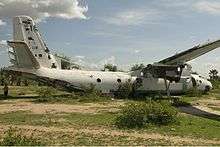
- 1982 Ethiopia. On 14 January 1982, an Ethiopian Air Force An-26 crashed near Addis Ababa, killing 73 Ethiopian, Libyan and Cuban troops.
- 1985 Afghanistan. On 4 September 1985, a Bakhtar Afghan Airlines An-26 was shot down by a SAM near Kandahar, killing all 52 people on board.
- 1986 Mozambique. On 30 March 1986, a Mozambique Air Force An-26 crashed while trying to land at Pemba Airport. All three crew and 41 of the 46 passengers were killed.
- 1987 Viet Nam. On 16 September 1987, a Viet Nam Air Force flight from Ha Noi to Ho-Chi-Minh City crashed at Bảo Lộc (Lâm Đồng) while on the approach to Ho-Chi-Minh City, killing all crew and passengers on board (31), mostly military personnel and their family members.[45]
- 1988 Angola. On 27 April 1988, a Cuban Air Force An-26 was accidentally shot down by Cuban troops stationed at Techamutete, killing all 29 people on board.
- 1988 Pakistan. On 10 December 1988, an Ariana Afghan Airlines An-26 was shot down by the Pakistan Air Force, killing all 25 people on board.
- 1992 Germany. On 27 February, a German Air Force An-26 "52+10" crashed after a hard landing. None of the crew members was injured.
- 1992 Libya. Yasir Arafat's An-26 crashed on 8 April 1992 during a sandstorm. Of the 13 on board, both pilots and an engineer were killed.
- 1994 Bosnia. On 31 July an Air Ukraine An-26B was downed in the northwest of the country, killing all 7 people on board.[46]
- 1995 Angola. On 16 January an Angolan Air Force An-26 was downed by rebel forces in the north of the country, killing all six occupants.[47]
- 1995 December India. On 17 December, terrorist Kim Davy alias Niels Holck from Denmark dropped several tonnes of lethal weapons, ammunition, explosives and triggers by An-26 in Purulia district of West Bengal State of India. The plane was forced to land in Bombay, where his accomplices were arrested.[48]
- 1997 Gogrial: Sudan Air Force Antonov An-26-100 crash-landed in 1997 at the airstrip of Gogrial Airport
- 1999 Nicaragua: On 21 January 1999, a Nicaraguan Air Force An-26 crashed after getting too low on approach and striking a tree near Bluefields Airport, killing all 28 people on board.
- 2003 Democratic Republic of the Congo. On 29 November 2003, a DRC Air Force An-26 crashed during takeoff due to a burst tyre, killing 20 of the 24 people on board and 13 people on the ground.
- 2005 Democratic Republic of the Congo. On 5 September, an An-26B operating on a non-scheduled passenger flight for Kavatshi Airlines struck a tree and crashed on approach to Isiro Airport in Matari, killing all 11 people on board.[49]
- 2005 Republic of the Congo. On 9 September, an An-26B operating on a non-scheduled passenger flight for Air Kasai crashed 50 km (31 miles) north of Brazzaville, killing all 13 people on board.[50]
- The 2007 Balad aircraft crash was a 9 January 2007 airplane incident involving an Antonov An-26 airliner, which crashed while attempting to land at the U.S. military base in Balad, Iraq.[3] The crash killed 34 passengers on board and left one critically injured.
- 2007 Democratic Republic of the Congo. On 4 October 2007 an Africa One-operated An-26 crashed into the Kinshasa neighbourhood of Kimbaseke just after takeoff. 21 out of 22 people on board and 28 people on the ground died. Initial reports indicate a lost propeller.
- 2008 Vietnam. On 8 April 2008 an An-26 crashed during a training mission near Hanoi, killing five Vietnamese military pilots.
- 2010 Exin's An-26B registered SP-FDO made an emergency landing on the Lake Ülemiste on 18 March 2010, close to Lennart Meri Tallinn Airport. None of the 6 crew members was injured. Initial reports indicated failure of one of the turboprop power plants.[51]
- 2010 Exin's ANn26B registered SP-FDP rejected takeoff from Tallinn's runway 08 at high speed when the gear collapsed or retracted during the takeoff roll on 25 August 2010. The airplane skidded to a stop on its belly, no injuries occurred.[52]
- 2011 Gabon. On 6 June 2011, a Solenta Aviation An-26 freighter flying for DHL Aviation crashed in the sea near Libreville, Gabon. Four people on board were rescued and transported to a local hospital, but were not seriously injured.[53]
- 2012 Sudan. On 19 August 2012, an An-26-100 flying for Alfa Airlines crashed on its second approach to the Talodi airfield in South Kordofan, Sudan. All 26 passengers on board and six crew members died.[54]
- 2014 Tunisia. On 21 February 2014, a Libyan military An-26, used for medical transportation, crashed in a farm near Grombalia, 60 km short of Tunis-Carthage Airport, after one of its engines caught fire. The accident resulted in the death of all its 11 passengers: six crew members, two doctors and three patients.[55]
- 2014 Ukraine. On 14 July 2014, a Ukrainian military An-26 transport aircraft flying at 21,000 feet (6,400 m) was shot down.[56] (confirmed to be shot using Buk missile system).[57] U.S. officials would later say evidence suggested the aircraft had been fired on from inside Russian territory[58]
- 2015 Syria. On 18 January 2015, an An-26 operated by the Syrian Air Force crashed while attempting to land at the besieged Abu al-Duhur military airport in Idlib Governorate, Syria.
- 2016 Bangladesh. On 9 March 2016, a True Aviation An-26 freighter crashed into the waters of the Bay of Bengal near Cox's Bazar while attempting to return to Cox's Bazar Airport following an engine failure.[59]
- 2016 Sudan. On 30 April 2016, an An-26 of the Sudan Air Force crashed during a landing attempt at Al-Ubayyid. All five crew members died.
- 2017 South Sudan. On 20 March 2017, a South Supreme Airlines An-26 was destroyed by fire after crashing at Wau Airport, South Sudan.
- 2017 Cuba. On 29 April 2017, an Aerogaviota An-26 crashed.[60]
- 2017 Russia, Saratov. On 30 May, a Russian An-26 defense military aircraft crashed.
- 2017 South Sudan. On 28 August 2017, An-26B EK-26006 of Coco Aviation overran the runway at Maban Airstrip and was destroyed by the consequent fire. The crew survived.[61]
- 2017 Ivory Coast. On 14 October 2017, Valan Air An-26, with registration ER-AVB chartered by the French Military crashed shortly before landing at Abidjan, the Ivory Coast capital. Four people were killed and six were injured.[62]
- 2018 Syria. On 6 March 2018 a Russian An-26 military transport plane crashed at Khmeimim Air Base. All 33 passengers and six crew died in the incident.[63]
- 2018 Democratic Republic of the Congo. On 20 December 2018, a Gomair An-26 registration 9S-AGB crashed 19 nautical miles short of Kinshasa with 7 or 8 people on board. The aircraft was found more than 24 hours later by a local. The aircraft was carrying election materials on behalf of the Central Electoral National Independent Commission (CENI).[64]
- 2018 Democratic Republic of the Congo. On 24 December 2018, an An-26 belonging to the Air Force of the Democratic Republic of the Congo crashed as it overshot the runway at Beni Airport in North Kivu province. The aircraft was reportedly transporting troops, and the crash resulted in 38 people being taken to hospital.[65]
Aircraft on display
- Poland
- An-26, tail number "1509" is exhibited in the Polish Aviation Museum in Kraków
- An-26, tail number "1602" is exhibited in the Polish Army Museum in Warsaw. The inside of the aircraft is open to visitors on Wednesdays, Saturdays and Sundays from 10 a.m. to 3 p.m. and on special occasions.
- Germany
- An-26, tail number "52+04", former East German "375", is exhibited at Technikmuseum Speyer
- An-26, tail number "52+05", former East German "376" is exhibited at Schwäbisches Bauern- und Technik-Museum, Eschach-Seifertshofen
- An-26, tail number "52+08", former East German "368" is exhibited at Flugausstellung Hermeskeil
- An-26SM, tail number "52+09", former East German "369", is exhibited at Militärhistorisches Museum Flugplatz Berlin-Gatow
- Pakistan
- AN-26, Afghan Air Force, is exhibited at PAF Museum, Karachi
Specifications
Data from Jane's All The World's Aircraft 1988–89[66]
General characteristics
- Crew: five ( two pilots, one radio operator, one flight engineer, one navigator)
- Capacity: 40 passengers / 5,500 kg (12,100 lb)
- Length: 23.8 m (78 ft 1 in)
- Wingspan: 29.3 m (96 ft 2 in)
- Height: 8.58 m (28 ft 2 in)
- Empty weight: 15,020 kg (33,113 lb)
- Max takeoff weight: 24,000 kg (52,911 lb)
- Powerplant: 2 × Progress AI-24VT Turboprop engines, 2,103 kW (2,820 hp) each
- Powerplant: 1 × Tumansky Ru-19-A300 Turbojet booster / APU, 7.85 kN (1,760 lbf) thrust
- Propellers: 4-bladed Constant speed metal bladed propellers
Performance
- Cruise speed: 440 km/h (270 mph, 240 kn)
- Range: 2,500 km (1,600 mi, 1,300 nmi) with maximum fuel
- Range with max payload: 1,100 km (680 mi)
- Service ceiling: 7,500 m (24,600 ft)
- Rate of climb: 8 m/s (1,600 ft/min)
See also
Related development
- Antonov An-24
- Antonov An-32
- Xian Y7
- Xian MA60
Aircraft of comparable role, configuration and era
Related lists
References
- Gordon, Yefim. Komissarov, Dmitry & Sergey. "Antonov's Turboprop Twins". Hinkley. Midland. 2003. ISBN 978-1-85780-153-8
- "Антонов Ан-26". Archived from the original on 23 October 2015. Retrieved 1 November 2015.
- ereeves (5 February 2015). "The infamous Antonov (An-24 and An-26) cargo planes/crude retrofitted bombers". Sudan Research, Analysis, and Advocacy. Archived from the original on 5 April 2015. Retrieved 14 August 2015.
- "The Aviationist » Russian warplanes used practice bombs with "To Berlin!" and "For Stalin" slogans during Baltic drills". The Aviationist. 14 August 2015. Archived from the original on 14 August 2015. Retrieved 14 August 2015.
- Hoyle 2016, p.29.
- Hoyle 2016, p.30.
- Hoyle 2016, p. 32
- Ogden (2008)
- Hoyle 2016, p. 33.
- "Ivory Coast Receives Two An-26Bs". Mönch. 3 August 2018. Archived from the original on 7 August 2018. Retrieved 7 August 2018.
- Hoyle 2016, p. 39.
- "1 листопада 2017 року на ДП "ЗАВОД 410 ЦА" відбулась передача відновленого літака Ан-26 Національної Гвардії Республіки Казахстан" (Press release) (in Ukrainian). Plant 410 CA. 1 November 2017. Archived from the original on 14 November 2017. Retrieved 3 November 2017.
- "Russia donates two An-26 aircraft to Kyrgyzstan Armed Forces". Air Recognition. 10 August 2017. Archived from the original on 12 August 2017. Retrieved 11 August 2017.
- "Kyrgyzstan to Receive Two Russian An-26 Transport Aircraft Next Week". Sputnik News. Bishkek. 1 August 2017. Archived from the original on 11 August 2017. Retrieved 11 August 2017.
- Hoyle 2016, p. 41.
- Hoyle 2016, p. 43.
- Sanchez, Alejandro (26 February 2018). "Russia donates two Antonov aircraft to Nicaragua". IHS Jane's 360. Washington, DC. Archived from the original on 27 February 2018. Retrieved 2 March 2018.
- Martin, Guy and David C. Isby. "Thrushes Operated by Puntland". Air International, May 2014. Vol. 86, No. 5. p. 25.
- Hoyle 2016, p. 45.
- Hoyle 2016, p. 46.
- Hoyle 2016, p. 47.
- Hoyle 2016, p. 48.
- Hoyle 2016, p. 49.
- Przeworski, Marcin (July 2017). "Transportowa Europa cz.II". Skrzydlata Polska (in Polish). No. 7(2453)/2017. pp. 38–46. ISSN 0137-866X.
- Hoyle 2016, p. 53.
- Wheeler, Barry (4 October 1980). "World's Air Forces". Flight. 118 (3726): 1326.
- Hungarian Armed Forces Website
- (in Polish) D. Sałata, K. Sałata, A. Wrona, Pożegnanie Ana-26 (Goodbye to An-26), "Skrzydlata Polska" Nr. 2/2009, p.28
- "World Air Forces 2017". Flight Global. Archived from the original on 31 July 2017. Retrieved 10 August 2017.
- "World Aif Forces 2016" (PDF). Flight Global. Archived (PDF) from the original on 10 August 2017. Retrieved 10 August 2017.
- Rossi, Marco (9 August 2017). "First flight for Slovak Spartan". Air Forces Monthly. Archived from the original on 10 August 2017. Retrieved 10 August 2017.
- "6th Special Operations Squadron Fact Sheet". Archived from the original on 5 December 2008.
- "Our Fleet". aerogaviota.com. Retrieved 8 September 2019.
- "ER-APV Accident description". Aviation Safety Network. Archived from the original on 14 October 2017. Retrieved 14 October 2017.
- "Fleet of airline". angara.aero. Retrieved 8 September 2019.
- "About company". chukotavia.com. Retrieved 8 September 2019.
- "IrAero - Company fleet". iraero.ru. Retrieved 8 September 2019.
- "Fleet". khbavia.ru. Retrieved 8 September 2019.
- "AEROTECHNICS". kostroma-avia.ru. Retrieved 8 September 2019.
- "An-26". ak-krasavia.ru. Retrieved 8 September 2019.
- "Парк ВС". polarair.ru. Retrieved 8 September 2019.
- "AN-26-100". antonov-airlines.com. Retrieved 8 September 2019.
- "Fleet". constantaairlines.com. Retrieved 8 September 2019.
- "Aircraft Specifications". vulkanair.com. Retrieved 8 September 2019.
- https://thanhnien.vn/thoi-su/tai-nan-may-bay-quan-su-32-nam-truoc-ky-1-285-mat-tich-1107889.html. Missing or empty
|title=(help) - https://aviation-safety.net/database/record.php?id=19940731-0
- Harro Ranter (16 January 1995). "ASN Aircraft accident Antonov 26 registration unknown North Angola". Archived from the original on 20 March 2015. Retrieved 26 December 2014.
- Purulia arms drop case
- Accident description at the Aviation Safety Network
- Accident description at the Aviation Safety Network
- Reed Business Information Limited. "Crashed An-26 had engine problem and aborted first approach". Archived from the original on 3 September 2011. Retrieved 26 December 2014.
- Hradecky, Simon. "Accident: Exin AN26 at Tallinn on Aug 25th 2010, gear collapse during takeoff". Aviation Herald. Archived from the original on 3 October 2018. Retrieved 26 August 2010.
- "DHL cargo plane crashes in Gabon, no fatalities". BNO News. Archived from the original on 21 February 2019. Retrieved 7 June 2011.
- "Sudan Plane Crash Kills Government Minister, Scores of Senior Officials". NYCAviation. BNO News. 20 August 2012. Archived from the original on 23 August 2012. Retrieved 21 August 2012.
- Laura Smith-Spark and Jomana Karadsheh, CNN (21 February 2014). "11 killed as Libyan military plane crashes in Tunisia". CNN. Archived from the original on 5 June 2014. Retrieved 26 December 2014.
- Sanchez, Raf (17 July 2014). "Ukrainian separatists suspected of bringing down Malaysia Airlines flight on Russian border". The Telegraph. Archived from the original on 17 July 2014. Retrieved 18 July 2014.
- "Today the self-defence destroyed An-26 airplane using SAM "9К37М1" (better known as 'Buk')", "Ополченцы сообщили, из чего сбили украинский Ан-26". Vzglyad. 14 July 2014. Archived from the original on 17 July 2014. Retrieved 18 July 2014.
- Peter Baker (18 July 2014), U.S. Sees Evidence of Russian Links to Jet's Downing Archived 2 March 2017 at the Wayback Machine The New York Times
- Accident description at the Aviation Safety Network
- Farrell, Paul (29 April 2017). "Aerogaviota Plane Crash: 5 Fast Facts You Need to Know". Heavy.com. Archived from the original on 29 April 2017.
- "EK-26006 Accident description". Aviation Safety Network. Archived from the original on 30 August 2017. Retrieved 29 August 2017.
- "Abidjan Antonov crash claims four lives". Air International. Vol. 93 no. 6. December 2017. p. 15. ISSN 0306-5634.
- В Минобороны РФ уточнили число погибших в авиакатастрофе Ан-26 в Сирии (in Russian). Zvezda. Archived from the original on 7 March 2018. Retrieved 6 March 2018.
- "Crash: Gomair AN26 near Kinshasa on Dec 20th 2018, impacted terrain short of runway". Retrieved 22 December 2018.
- Cherisey, de, Erwan (2 January 2019). "DRC air force An-26 crashes". Jane's 360. Paris. Archived from the original on 3 January 2019. Retrieved 3 January 2019.
- Taylor (1988), pp. 222–223.
- Chant, Christopher. Commercial Aircraft and Airline Markings
- Gordon, Yefim. Komissarov, Dmitry & Sergey. Antonov's Turboprop Twins. Hinkley. Midland. 2003. ISBN 978-1-85780-153-8
- Hoyle, Craig (8–14 December 2015). "World Air Forces". Flight International. Vol. 188 no. 5517. pp. 26–53.
- Hoyle, Craig (6–12 December 2016). "World Air Forces Directory". Flight International. Vol. 190 no. 5566. pp. 22–53.
- Ogden, Bob (2008). Aviation Museums and Collections of The Rest of the World. UK: Air-Britain. ISBN 978-0-85130-394-9
- Taylor, John W.R. 1988. Jane's All The World's Aircraft 1988–89. Coulsdon, UK: Jane's Defence Data. ISBN 978-0-7106-0867-3.
External links
| Wikimedia Commons has media related to Antonov An-26. |
- Pictures of An-26 at Airliners.net
- https://web.archive.org/web/20061023125914/http://www.antonov.com/about/an-26.xml
- https://web.archive.org/web/20061103104838/http://www.aeronautics.ru/an26a.jpg
- http://rus.air.ru/airplanes/images/An-26pict.htm
- http://www.transportflieger.eu
- http://www.luroko.de
- Details of An-26 at EnglishRussia.com